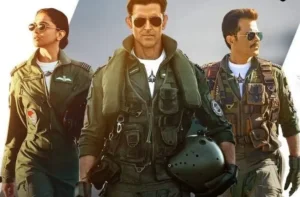The artistically magnificent fictitious period picture “Malaikottai Vaaliban,” directed by Lijo Jose Pellissery and starring Mohanlal, is about a wrestler with superhuman abilities. However, our review points out that the plot is shallow.
Star of Malayalam cinema Mohanlal returned with “Neru” following a run of failures. Expectations were naturally high for the masterfully staged “Malaikottai Vaaliban,” considering that Mohanlal and Lijo Jose Pellissery were working together for the first time. Has “Malaikottai Vaaliban” fulfilled the hype? Let’s investigate!
Along with Chinna and Ayyanar (Hareesh Peradi), Malaikottai Vaaliban (Mohanlal) is an undefeated warrior who travels to different terrains to fight various opponents. He meets his opponent, Chamathakan (Danish Sait), during a battle; in the village of Mangodu, he crafts Mangottu Mallan (Guinness Harikrishnan). Vaaliban beats Mallan as predicted, having a long-lasting effect on Chamathakan’s life. Chamathakan chooses to take revenge by following Vaaliban with a vengeance.
After that, Vaaliban goes back to Malaikottai, his village, and confronts the British. Nevertheless, fresh issues surface in Malaikottai, creating a split in the connections he has thus far fostered. This forces Vaaliban to find out the truth and have a last showdown.
In the Malayalam cinema business, director Lijo Jose Pellissery has a distinct voice. We’re constantly interested in the subjects he tackles and the ways he defies cinematic conventions in his works. To suggest that “Malaikottai Vaaliban” is a visually magnificent film would be an understatement. Your jaw will drop at the quality of every single frame and the overall filming technique.
Here’s the trailer:
On the other hand, “Malaikottai Vaaliban” by Lijo Jose Pellissery confuses you. The movie hardly moves forward and stays inert for the first half of its runtime. As we watch, Mohanlal’s Vaaliban defeats one adversary after another with his superhuman skills. His superhuman skills are highlighted more in the action choreography than his genuine kushthi (wrestling) skills.
By the time the second half of the plot comes together, your patience will be tested. Certain set pieces, like the carnival scene or the scene where Vaaliban challenges the British, are masterfully done such that you have to keep looking forward to see what comes next. But because the plot is so straightforward, its effect is diminished by its over two hours and thirty minute duration.
At the movie’s conclusion, Ayyanar gives the history, presents Vaaliban’s ultimate adversary, and makes a fascinating connection to the film’s follow-up. Although there are certain “peak cinema” moments in several of the episodes, “Malaikottai Vaaliban” lacks a cogent storyline. There’s a section about the British enslaving the people of Malaikottai, and there are references to the late actor-politician MG Ramachandran. All of these concepts, meanwhile, are cut off suddenly and lack sufficient development.
In “Malaikottai Vaaliban,” Mohanlal is at his best. He is outstanding, displaying everything from intense emotions to well orchestrated action blocks. Danish Sait’s portrayal in a serious part is outstanding. In the historical actioner, his character development is the most compelling. In “Malaikottai Vaaliban,” the women seldom had anything to say.
Cinematographer Madhu Neelakandan’s work deserves all awards. Prashant Pillai’s music elevates the sequences and gives the much-needed hype in many important sequences.
‘Malaikottai Vaaliban’ could have been a crisp film had the narrative had enough meat in the first half. However, the film sets up a great segue for the second part.



